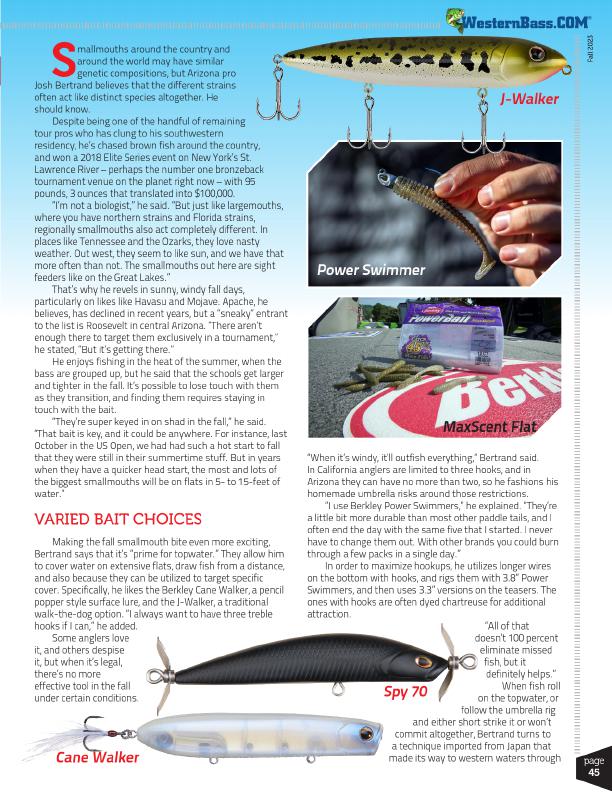
®
S
mallmouths around the country and
around the world may have similar
genetic compositions, but Arizona pro Josh Bertrand believes that the different strains
often act like distinct species altogether. He
should know.
Despite being one of the handful of remaining
tour pros who has clung to his southwestern
residency, he’s chased brown fish around the country,
and won a 2018 Elite Series event on New York’s St.
Lawrence River – perhaps the number one bronzeback
tournament venue on the planet right now – with 95
pounds, 3 ounces that translated into $100,000.
“I’m not a biologist,” he said. “But just like largemouths,
where you have northern strains and Florida strains,
regionally smallmouths also act completely different. In
places like Tennessee and the Ozarks, they love nasty
weather. Out west, they seem to like sun, and we have that
more often than not. The smallmouths out here are sight
feeders like on the Great Lakes.”
That’s why he revels in sunny, windy fall days,
particularly on likes like Havasu and Mojave. Apache, he
believes, has declined in recent years, but a “sneaky” entrant
to the list is Roosevelt in central Arizona. “There aren’t
enough there to target them exclusively in a tournament,”
he stated, “But it’s getting there.”
He enjoys fishing in the heat of the summer, when the
bass are grouped up, but he said that the schools get larger
and tighter in the fall. It’s possible to lose touch with them
as they transition, and finding them requires staying in
touch with the bait.
“They’re super keyed in on shad in the fall,” he said.
“That bait is key, and it could be anywhere. For instance, last
October in the US Open, we had had such a hot start to fall
that they were still in their summertime stuff. But in years
when they have a quicker head start, the most and lots of
the biggest smallmouths will be on flats in 5- to 15-feet of
water.”
VARIED BAIT CHOICES
Making the fall smallmouth bite even more exciting, Bertrand says that it’s “prime for topwater.” They allow him to cover water on extensive flats, draw fish from a distance, and also because they can be utilized to target specific cover. Specifically, he likes the Berkley Cane Walker, a pencil popper style surface lure, and the J-Walker, a traditional walk-the-dog option. “I always want to have three treble hooks if I can,” he added.
Some anglers love it, and others despise it, but when it’s legal, there’s no more effective tool in the fall under certain conditions.
Cane Walker
J-Walker
Power Swimmer
MaxScent Flat
“When it’s windy, it’ll outfish everything,” Bertrand said.
In California anglers are limited to three hooks, and in
Arizona they can have no more than two, so he fashions his
homemade umbrella risks around those restrictions.
“I use Berkley Power Swimmers,” he explained. “They’re
a little bit more durable than most other paddle tails, and I
often end the day with the same five that I started. I never
have to change them out. With other brands you could burn
through a few packs in a single day.”
In order to maximize hookups, he utilizes longer wires
on the bottom with hooks, and rigs them with 3.8” Power
Swimmers, and then uses 3.3” versions on the teasers. The
ones with hooks are often dyed chartreuse for additional
attraction.
“All of that
doesn’t 100 percent
eliminate missed
fish, but it
definitely helps.”
Spy 70
When fish roll on the topwater, or
follow the umbrella rig
and either short strike it or won’t
commit altogether, Bertrand turns to
a technique imported from Japan that
made its way to western waters through
Fall 2023
page 45